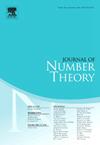SO+(2,n + 2) 的赫克理论
IF 0.6
3区 数学
Q3 MATHEMATICS
引用次数: 0
摘要
我们描述了正交群 SO+(2,n+2)的赫克理论基础。特别是,我们将阶数为 2 的赫米特模数群视为 SO+(2,4) 的一个特例。作为应用,我们证明了所附的 Maaß 空间在赫克算子作用下是不变的。这意味着爱森斯坦数列属于 Maaß 空间。如果底层晶格是偶数和单调的,我们的方法就能重新证明其傅里叶系数的明确公式。本文章由计算机程序翻译,如有差异,请以英文原文为准。
Hecke theory for SO+(2,n + 2)
We describe the foundations of a Hecke theory for the orthogonal group . In particular we consider the Hermitian modular group of degree 2 as a special example of . As an application we show that the attached Maaß space is invariant under Hecke operators. This implies that the Eisenstein series belongs to the Maaß space. If the underlying lattice is even and unimodular, our approach allows us to reprove the explicit formula of its Fourier coefficients.
求助全文
通过发布文献求助,成功后即可免费获取论文全文。
去求助
来源期刊

Journal of Number Theory
数学-数学
CiteScore
1.30
自引率
14.30%
发文量
122
审稿时长
16 weeks
期刊介绍:
The Journal of Number Theory (JNT) features selected research articles that represent the broad spectrum of interest in contemporary number theory and allied areas. A valuable resource for mathematicians, the journal provides an international forum for the publication of original research in this field.
The Journal of Number Theory is encouraging submissions of quality, long articles where most or all of the technical details are included. The journal now considers and welcomes also papers in Computational Number Theory.
Starting in May 2019, JNT will have a new format with 3 sections:
JNT Prime targets (possibly very long with complete proofs) high impact papers. Articles published in this section will be granted 1 year promotional open access.
JNT General Section is for shorter papers. We particularly encourage submission from junior researchers. Every attempt will be made to expedite the review process for such submissions.
Computational JNT . This section aims to provide a forum to disseminate contributions which make significant use of computer calculations to derive novel number theoretic results. There will be an online repository where supplementary codes and data can be stored.
 求助内容:
求助内容: 应助结果提醒方式:
应助结果提醒方式:


